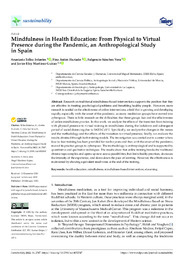Por favor, use este identificador para citar o enlazar este ítem:
https://hdl.handle.net/11000/31234Registro completo de metadatos
| Campo DC | Valor | Lengua/Idioma |
|---|---|---|
| dc.contributor.author | Téllez Infantes, Anastasia | - |
| dc.contributor.author | Anton, Fina | - |
| dc.contributor.author | Sánchez Vera, Fulgencio | - |
| dc.contributor.author | Martínez Guirao, Javier Eloy | - |
| dc.contributor.other | Departamentos de la UMH::Ciencias Sociales y Humanas | es_ES |
| dc.date.accessioned | 2024-02-07T13:59:27Z | - |
| dc.date.available | 2024-02-07T13:59:27Z | - |
| dc.date.created | 2022-02 | - |
| dc.identifier.citation | Sustainability 2022, 14(5) | es_ES |
| dc.identifier.issn | 2071-1050 | - |
| dc.identifier.uri | https://hdl.handle.net/11000/31234 | - |
| dc.description.abstract | Research on traditional mindfulness-based interventions supports the position that they are effective in treating psychological problems and benefiting healthy people. However, more research is needed on the effectiveness of online interventions, a field that is growing and developing rapidly, especially with the onset of the pandemic, as many meditation groups have moved into cyberspace. There is little research on the difficulties that these groups face and the effectiveness of online mindfulness practice. In this work, we analyze the effects of the transition from training with physical presence to virtual training in mindfulness during the lockdown and subsequent period of social distancing due to SARS-CoV-2. Specifically, we analyze the changes in the means and the methodology and the effects of the transition to virtual presence; finally, we evaluate the results obtained through both training models. The investigation was carried out in a center where face-to-face training has been provided for twelve years and that, with the onset of the pandemic, moved its practice groups to cyberspace. The methodology is anthropological and is supported by quantitative and qualitative techniques. The results show that online training breaks the traditional chrono-topo complex and opens up new access possibilities, but limits bodily practices, decreases the intensity of the experience, and slows down the pace of learning. However, the effectiveness is maintained by showing equivalent result rates at the end of the training | es_ES |
| dc.format | application/pdf | es_ES |
| dc.format.extent | 19 | es_ES |
| dc.language.iso | eng | es_ES |
| dc.publisher | MDPI | es_ES |
| dc.rights | info:eu-repo/semantics/openAccess | es_ES |
| dc.rights | Attribution-NonCommercial-NoDerivatives 4.0 Internacional | * |
| dc.rights.uri | http://creativecommons.org/licenses/by-nc-nd/4.0/ | * |
| dc.subject | health education | es_ES |
| dc.subject | mindfulness | es_ES |
| dc.subject | mindfulness-based intervention | es_ES |
| dc.subject | eLearning | es_ES |
| dc.subject.other | CDU:572 - Antropología | es_ES |
| dc.title | Mindfulness in Health Education: From Physical to Virtual Presence during the Pandemic, an Anthropological Study in Spain | es_ES |
| dc.type | info:eu-repo/semantics/article | es_ES |
| dc.relation.publisherversion | https://doi.org/10.3390/su14052547 | es_ES |

Ver/Abrir:
sustainability-14-02547 (1).pdf
1,52 MB
Adobe PDF
Compartir:
 La licencia se describe como: Atribución-NonComercial-NoDerivada 4.0 Internacional.
La licencia se describe como: Atribución-NonComercial-NoDerivada 4.0 Internacional.
.png)